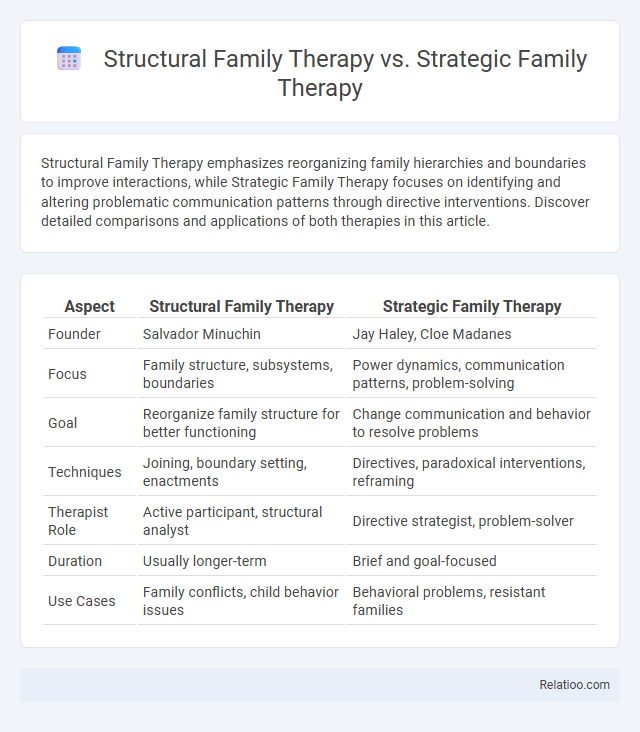Structural Family Therapy emphasizes reorganizing family hierarchies and boundaries to improve interactions, while Strategic Family Therapy focuses on identifying and altering problematic communication patterns through directive interventions. Discover detailed comparisons and applications of both therapies in this article.
Table of Comparison
| Aspect | Structural Family Therapy | Strategic Family Therapy |
|---|---|---|
| Founder | Salvador Minuchin | Jay Haley, Cloe Madanes |
| Focus | Family structure, subsystems, boundaries | Power dynamics, communication patterns, problem-solving |
| Goal | Reorganize family structure for better functioning | Change communication and behavior to resolve problems |
| Techniques | Joining, boundary setting, enactments | Directives, paradoxical interventions, reframing |
| Therapist Role | Active participant, structural analyst | Directive strategist, problem-solver |
| Duration | Usually longer-term | Brief and goal-focused |
| Use Cases | Family conflicts, child behavior issues | Behavioral problems, resistant families |
Introduction to Family Therapy Approaches
Structural Family Therapy focuses on realigning family hierarchies and boundaries to improve relational dynamics, utilizing techniques like enactments to reveal interaction patterns. Strategic Family Therapy emphasizes problem-solving through directive interventions and paradoxical strategies aimed at disrupting dysfunctional cycles within the family system. Your choice between these approaches in Family Therapy depends on whether the goal is to modify family structure, address specific behaviors strategically, or integrate a broader therapeutic framework tailored to the family's unique needs.
Overview of Structural Family Therapy
Structural Family Therapy emphasizes the organization and hierarchy within a family system, aiming to realign boundaries and improve communication patterns. Developed by Salvador Minuchin, it focuses on modifying subsystems and restructuring interactions to enhance family functioning. This approach contrasts with Strategic Family Therapy, which targets problem-solving through directive interventions and paradoxical techniques.
Core Principles of Strategic Family Therapy
Strategic Family Therapy emphasizes identifying and altering dysfunctional family interaction patterns through deliberate interventions tailored to disrupt negative cycles and encourage new behaviors. Core principles include identifying the presenting problem as a symptom of systemic dysfunction, using directives to provoke change, and focusing on hierarchical family structures to balance power dynamics. Structural Family Therapy concentrates on altering family organization and subsystems to improve functionality, while Family Therapy broadly addresses relational dynamics to enhance communication and resolve conflicts.
Key Differences Between Structural and Strategic Therapy
Structural Family Therapy emphasizes reorganizing family hierarchy and boundaries to improve interaction patterns, focusing on family structure and subsystems. Strategic Family Therapy targets specific problems by using planned interventions and directives to change family behaviors and communication, often using paradoxical techniques. The key difference lies in Structural Therapy's focus on restructuring underlying family organization, whereas Strategic Therapy concentrates on altering problematic behaviors through strategic problem-solving methods.
Techniques Used in Structural Family Therapy
Structural Family Therapy employs techniques such as joining, boundary making, and unbalancing to reorganize family structures and improve interactions. Strategic Family Therapy focuses on problem-solving strategies and directive interventions to alter dysfunctional behavior patterns within the family system. Your choice between these approaches depends on whether you seek to shift family hierarchies through structural interventions or modify specific behaviors using strategic techniques.
Interventions in Strategic Family Therapy
Strategic Family Therapy emphasizes direct interventions designed to disrupt dysfunctional family patterns and solve specific problems, often using paradoxical tasks and directives tailored to alter family interactions immediately. Unlike Structural Family Therapy, which reorganizes family hierarchies and boundaries, Strategic Therapy focuses on sequences of communication to modify behavior without deep exploration of underlying issues. Your understanding of these targeted strategies can enhance therapy outcomes by promoting rapid change through carefully planned, goal-oriented interventions.
Therapist Roles: Structural vs Strategic Approaches
In Structural Family Therapy, therapists actively map family hierarchies and boundaries, intervening to reorganize interactions and reinforce healthy subsystem structures. Strategic Family Therapy therapists adopt a directive role, designing specific tasks and interventions to change problematic family patterns through carefully planned strategies. Both approaches position the therapist as an agent of change, but Structural emphasizes restructuring family dynamics while Strategic focuses on disrupting dysfunctional sequences through tactical interventions.
Benefits and Challenges of Each Model
Structural Family Therapy emphasizes reorganizing family hierarchies to improve communication and relationships, benefiting families facing boundary and coalition issues but challenging when members resist change. Strategic Family Therapy uses directive interventions to solve specific problems quickly, benefiting families needing clear guidance yet risking superficial changes without addressing underlying dynamics. Family Therapy as a broader approach offers flexibility to tailor techniques for diverse issues, benefiting your unique family needs but can be less focused, requiring more time to achieve lasting results.
Choosing the Right Family Therapy Approach
Choosing the right family therapy approach depends on the specific needs and dynamics of the family system. Structural Family Therapy emphasizes reorganizing family roles and hierarchy to improve interactions, while Strategic Family Therapy focuses on resolving problems through direct interventions and strategic communication patterns. Selecting between these and general Family Therapy involves assessing goals such as behavioral change, system restructuring, or symptom relief to tailor treatment effectively.
Conclusion: Structural vs Strategic Family Therapy
Structural Family Therapy emphasizes reorganizing family hierarchies and boundaries to improve family functioning, while Strategic Family Therapy focuses on resolving problems through planned interventions and communication patterns. Both approaches aim to modify dysfunctional interactions but differ in techniques: Structural therapy restructures family roles, whereas Strategic therapy employs directive strategies to influence behavior change. Choosing between these modalities depends on the specific family dynamics and therapeutic goals targeted for effective treatment outcomes.

Infographic: Structural Family Therapy vs Strategic Family Therapy
 relatioo.com
relatioo.com